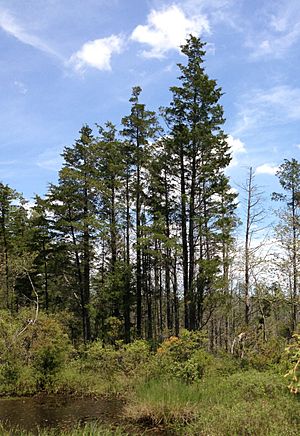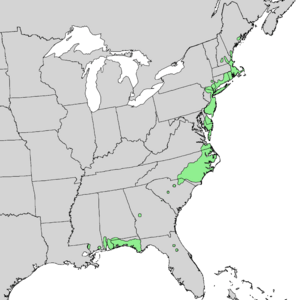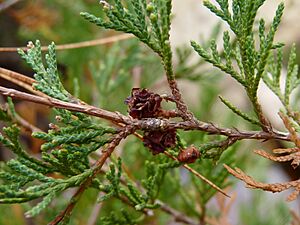Atlantic white cedar facts for kids
Quick facts for kids Atlantic white cedar |
|
|---|---|
 |
|
| Chamaecyparis thyoides near the edge of a bog in New Jersey | |
| Conservation status | |
| Scientific classification | |
| Genus: |
Chamaecyparis
|
| Species: |
thyoides
|
 |
|
| Natural range of Chamaecyparis thyoides | |
The Atlantic white cedar (Chamaecyparis thyoides) is a type of cypress tree. It is also known as Atlantic white cypress or southern white cedar. This tree grows naturally along the Atlantic coast of North America. You can find it from southern Maine all the way to Georgia. It also grows along the Gulf of Mexico coast, from Florida to Mississippi.
This tree is one of two Chamaecyparis species in North America. The Atlantic white cedar lives on the East Coast. Its relative, C. lawsoniana, lives on the West Coast.
There are two main types, or subspecies, of Atlantic white cedar. Some scientists think they are different species. Others see them as just variations. These are Chamaecyparis thyoides thyoides and Chamaecyparis thyoides henryae. These trees usually grow in wetlands where they are often the tallest trees. They grow with many other wetland plants. Most remaining groups of these trees are in hard-to-reach places. This means they are not cut down for lumber as much anymore.
Contents
Where It Grows and Lives
The Atlantic white cedar usually grows within 100 miles of the coast. It is found less than 50 meters above sea level. This is true for most of the East Coast and Gulf Coast. Some rare groups grow in the Appalachian Mountains foothills. There, they can be found up to 460 meters above sea level.
Many Atlantic white cedar forests are protected. You can find them in places like the Great Dismal Swamp National Wildlife Refuge. They are also in the Alligator River National Wildlife Refuge and Cape Cod National Seashore. Other protected areas include Croatan National Forest and Francis Marion National Forest. They are also found in Ocala National Forest and Apalachicola National Forest.
Outside of these protected areas, many forests have shrunk. This is due to changes in fire regimes, logging, and draining of wetlands. The tree is listed as Rare in Georgia and New York. It is of Special Concern in Maine. It has disappeared from Pennsylvania.
Atlantic white cedar trees almost always live in freshwater wetlands. They need soil that is wet for most of the growing season. The soil in these areas has a thick layer of organic material. It often has sandy material deeper down. The soil does not drain well. Atlantic white cedar wetlands are also acidic. There is little oxygen in the soil because water fills the air spaces. Plants that live here must be special to handle these conditions.
The Atlantic white cedar tree itself is not considered threatened. However, its wetland homes are a globally threatened ecosystem. These wetlands are important carbon sinks. This means they store carbon, which helps the environment. They do this by building up peat.
How It Lives with Others
Red maple and black gum trees often grow alongside Atlantic white cedar. You can also find Sphagnum mosses in these wetlands. The caterpillar of the Hessel's Hairstreak butterfly eats only C. thyoides leaves. Its green color helps it blend in, or be camouflaged.
The trees often grow on small mounds called hummocks. Water collects in the dips around them. This keeps the tree from being underwater all the time. It also helps protect them from floods. The tree benefits from small, regular fires. These fires clear out other plants. This allows young trees, called seedlings, to get sunlight. It also limits competition from other plants, especially Red Maple. Fires that are too strong or too often can harm seedlings and grown trees. Too much flooding can also hurt them.
What It Looks Like
The Atlantic white cedar is an evergreen coniferous tree. This means it keeps its leaves all year round. It usually grows to about 20 to 28 meters (65 to 90 feet) tall. Some can grow up to 35 meters (115 feet) tall. The trunk is usually about 0.8 meters (2.6 feet) wide. Some can be up to 2 meters (6.5 feet) wide.
Its leaves are like scales, about 2 to 4 millimeters long. They grow in flat sprays. The color is green to blue-green. Young trees (under one year old) have needle-like leaves. The lower three-fourths of the trunk usually has no branches. The bark can be ash-gray to reddish brown. Young trees have smooth bark. Older trees have deep ridges. Their bark can be as thick as 5 centimeters (2 inches).
C. thyoides is monoecious. This means one tree has both male and female parts. It carries both pollen and seeds in its cones. The seed cones are round. They are about 4 to 9 millimeters wide. They have 6 to 10 scales, with 1 to 2 seeds per scale. They start green or purple and turn brown in 5 to 7 months. The pollen cones are yellow. They turn brown as the tree gets older. They are about 1.5 to 3 millimeters long. They release their yellow pollen once a year in spring.
The tree starts making seeds when it is 4 to 5 years old. But it doesn't make many cones until it is 10 to 20 years old. Seeds are spread almost every year by the wind. The tree grows taller and wider until it is about 50 years old. Then, height growth slows down. Both height and width stop increasing when the tree is about 100 years old. Most groups of these trees are younger than 200 years. However, some trees as old as 1000 years have been found. Because their roots are not very deep, C. thyoides trees can be blown over by strong winds.
Different Types of Atlantic White Cedar
- Chamaecyparis thyoides thyoides: Its leaves and young cones are usually blue-green. The cones turn dark brown or black when they are mature. The leaves are flat and have small, visible glands.
- Chamaecyparis thyoides henryae: Its leaves and young cones are green. They are not blue-green. The cones turn light brown when they are mature. The leaves have a ridge down the middle. Their glands are harder to see or are missing.
What It's Used For
The Atlantic white cedar is important in horticulture, which is garden growing. Many different types, called cultivars, have been chosen for gardens. These have different shapes, growth rates, and leaf colors. Some popular types include 'Aurea' (yellow leaves) and 'Heatherbun' (small, turns purple in winter). 'Glauca' has very blue-green leaves. In some places, like Mobile County, Alabama, the tree is grown as a Christmas tree.
Its Wood
The wood of the Atlantic white cedar is very strong. It resists decay and warping in different temperatures and wetness. The most common use for this wood is lumber. Trees usually need about 70 years to grow before they can be cut for lumber. This lumber can be used to build houses. However, it's hard to find enough Atlantic white cedar to build a whole house.
The wood was once popular for roof shingles because it is light. But now, cheaper and more fire-resistant materials like asphalt are used instead. The strong inner wood, called heartwood, is good for siding and paneling on houses. The outer wood, called sapwood, is less strong. It has been used for inside finishes. White cedar lumber has also been used to build boats. This needs very old, large trees. North Carolina makes the most lumber for boats. This is because it has the most old-growth C. thyoides forests.
Other uses for the wood include fencing, telephone poles, and electric poles. It is also used for wooden items, duck decoys, and outdoor furniture. And, as mentioned, it can be used as a Christmas tree.
Gallery
See also
 In Spanish: Falso ciprés blanco para niños
In Spanish: Falso ciprés blanco para niños







